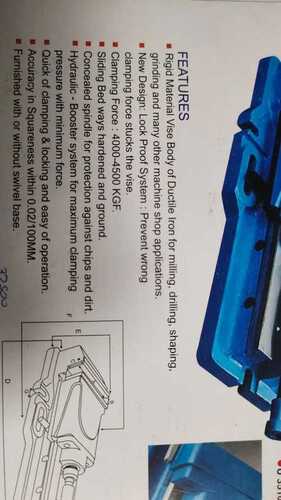
Indexing milling fixture horizontal and vertical
Product Details:
- Dimension (L*W*H) 200X110X185 Millimeter (mm)
- Weight (kg) 24 Kilograms (kg)
- Warranty 6 MONTH
- Click to view more
Indexing milling fixture horizontal and vertical Price And Quantity
- 66400 INR/Unit
- 1 Unit
Indexing milling fixture horizontal and vertical Product Specifications
- 6 MONTH
- 200X110X185 Millimeter (mm)
- 24 Kilograms (kg)
Indexing milling fixture horizontal and vertical Trade Information
- 1 Week
- Yes
- Within a certain price range free samples are available
- Africa Middle East Asia
- All India
Product Description
Indexing milling fixtures are essential tools in machining operations to hold and position workpieces precisely for various milling and drilling operations. These fixtures come in horizontal and vertical configurations, allowing for versatile machining capabilities. Here's a brief overview of both types:
- Horizontal Indexing Milling Fixture:A horizontal indexing milling fixture is designed for use on horizontal milling machines. It allows for the precise rotation and positioning of a workpiece around a horizontal axis. Key features of a horizontal indexing milling fixture include:
-
Rotational Capability: It enables the workpiece to be rotated in specific angular increments, typically in 1, 5, or 15 steps. This is achieved through the use of a dividing plate, indexing crank, and a worm gear mechanism.
-
Spindle Alignment: The fixture is designed to align the workpiece with the horizontal spindle of the milling machine, allowing for horizontal milling operations.
-
Versatility: Horizontal fixtures are suitable for a wide range of machining tasks, such as cutting keyways, slots, and grooves.
-
Precision: They provide accurate positioning and repeatability for precise machining operations.
- Vertical Indexing Milling Fixture:A vertical indexing milling fixture is designed for use on vertical milling machines. It allows for the accurate rotation and positioning of a workpiece around a vertical axis. Key features of a vertical indexing milling fixture include:
-
Rotational Capability: Similar to horizontal fixtures, it allows for precise angular positioning of the workpiece. The indexing mechanism is generally located at the base of the fixture.
-
Spindle Alignment: The fixture is designed to align the workpiece with the vertical spindle of the milling machine, making it suitable for vertical milling, drilling, and boring operations.
-
Versatility: Vertical fixtures are commonly used for operations like milling keyways, gear teeth, splines, and fluting.
-
Precision: They offer high precision and repeatability, ensuring that each machined feature is accurately located on the workpiece.
In both horizontal and vertical indexing milling fixtures, accurate indexing is achieved through the use of dividing plates and a crank handle or worm gear. The workpiece is clamped securely to the fixture, and the indexing mechanism allows for the desired angular rotation. This ensures that the milling or drilling operations are carried out at precise intervals, resulting in accurate and repeatable machined features.
These fixtures are widely used in various industries, including manufacturing, tool and die making, and general machining, to improve efficiency and precision in milling and drilling operations.

Price:
- 50
- 100
- 200
- 250
- 500
- 1000+
 English
English Spanish
Spanish French
French German
German Italian
Italian Chinese (Simplified)
Chinese (Simplified) Japanese
Japanese Korean
Korean Arabic
Arabic Portuguese
Portuguese







